 |

Botanical Society of the British Isles
Field Meeting in the Picos de Europa
led by Teresa Farino and Lynne Farrell
31 May - 9 June 2004
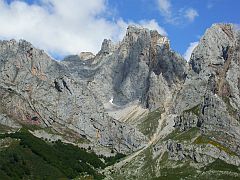 Western massif from Valdeón© Teresa Farino Fourteen BSBI members flew to Bilbao to join the leaders, Lynne Farrell and Teresa Farino. Teresa has lived in the Picos de Europa since 1986, and is a relative expert in comparison to Lynne, who had only visited the Picos once before, but had been charmed by its scenery and natural history. Once the group had congregated, following a sumptuous lunch for some in a cider-house in Loiu, we set off in two rather large minibuses, which Teresa was used to driving but presented a steep learning curve for Lynne. After about three hours we reached the first of our two family-run hotels, this one in the delightful village of Espinama, where - despite the late hour - we managed to do justice to the magnificent local cuisine. Western massif from Valdeón© Teresa Farino Fourteen BSBI members flew to Bilbao to join the leaders, Lynne Farrell and Teresa Farino. Teresa has lived in the Picos de Europa since 1986, and is a relative expert in comparison to Lynne, who had only visited the Picos once before, but had been charmed by its scenery and natural history. Once the group had congregated, following a sumptuous lunch for some in a cider-house in Loiu, we set off in two rather large minibuses, which Teresa was used to driving but presented a steep learning curve for Lynne. After about three hours we reached the first of our two family-run hotels, this one in the delightful village of Espinama, where - despite the late hour - we managed to do justice to the magnificent local cuisine.
1 June - Espinama to Fuente Dé
Our first excursion was on foot directly from the hotel along a footpath bordered by rich verges. Progress was fairly
slow owing to the many new and familiar plants found, including Silene nutans (Nottingham Catchfly),
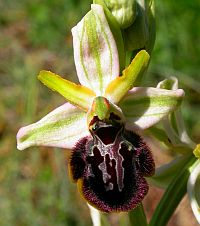 Early Spider Ophrys
Early Spider Ophrys
Ophrys sphegodes
© Teresa Farino
Valeriana pyrenaica (Pyrenean Valerian), Draba muralis (Wall Whitlowgrass) and Geranium purpureum
(Little Robin). Climbing gently onwards towards Fuente Dé, we came to richer and highly colourful meadows with abundant
Rhinanthus, mainly R. serotinus ssp. asturicus (Greater Yellow Rattle), the pink form of
Anthyllis vulneraria (Kidney Vetch), Geranium sanguineum (Bloody Crane's-bill) and Echium vulgare
(Viper's Bugloss) the banks covered with the Picos endemic greenweed Genista legionensis.
The scenery up to the nearby peaks - some more than 2,000 metres - was wonderful and so was the show of
Ophrys tenthredinifera (Sawfly Orchid), growing with O. sphegodes (Early Spider-orchid),
O. fusca (Dull Orchid),and Aceras anthropophorum (Man Orchid).
In the nearby woodland were tall stems of Lilium martagon (Martagon Lily) still in bud.
After lunch we explored a wet meadow, treading carefully so as not to damage the hay crop. More orchids were found
such as the yellow form of Dactylorhiza sambucina (Elder-flowered Orchid),
Orchis mascula (Early-purple Orchid), and Orchis ustulata (Burnt Orchid),
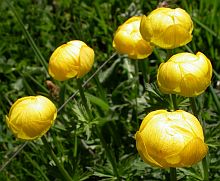 Globeflower
Globeflower
Trollius europaeus
© Teresa Farino
Serapias lingua (Tongue Orchid) together with Trollius europaeus (Globeflower),
Asphodelus albus (White Asphodel), Potentilla rupestris (Rock Cinquefoil) and Dianthus deltoides
(Maiden Pink). In the flushes were Parnassia palustris (Grass-of-Parnassus), Pedicularis verticillata
(Whorled Lousewort), Anagallis tenella (Bog Pimpernel), Eriophorum latifolium (Broad-leaved Cottongrass),
Cardamine raphanifolia (Greater Cuckooflower) and Hypericum undulatum (Wavy St John's-wort).
Along a shady path we found Dactylorhiza sulphurea and D. insularis
(Barton's orchid), which are very similar in appearance at first acquaintance.
Neotinea nidus-avis (Bird's-nest Orchid) and Paris quadrifolia (Herb-Paris)
were seen in the beechwood while we
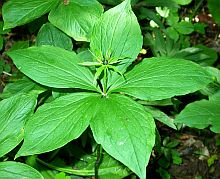 Herb-Paris
Herb-Paris
Paris quadrifolia
© Teresa Farino
listened in vain for Black Woodpeckers. The downwards track led us through slopes of the blooming yellow bushes of the Genista hispanica ssp. occidentalis (Spanish Gorse), where we chased a myriad butterflies and tried to photograph the singing Field Crickets.
2 June - Urdón & Tudes
After a quick examination of the moth trap, whose tenants included a fabulous 'rusty' tiger moth called
Hyphoraia dejeani and the Small Ranunculus, extinct in Britain since 1939, the second day saw us heading down
the Deva valley. A quick stop in the market town of Potes turned up Campanula erinus (Annual bellflower)
and Phagnalon rupestre on a wall, from which we headed north through the two-kilometre-deep La Hermida Gorge,
where no direct sunlight falls for five months of the year.
 Sticky Flax
Sticky Flax
Linum viscosum
© Teresa Farino
Walking up the side gorge of the River Urdón, we gazed at the near-vertical rock-gardens where Erigeron
karvinskianus (Mexican Fleabane) and Antirrhinum braun-blanquetii were growing with the Picos endemics
Linaria faucicola and Petrocoptis pyrenaica ssp. glaucifolia (Blue-leaved Petrocoptis). Several
yellow crucifers - Erysimum duriaei, Biscutella valentina ssp. valentina var.
laevigata (Buckler Mustard) and Coincya monensis ssp. cheiranthos (Wallflower Cabbage) -
grew with the lilac-flowered Globularia nudicaulis (Leafless-stemmed Globularia) and the pink Linum
viscosum (Sticky Flax). Shrubs included Prunus mahaleb (St Lucie's Cherry), Jasminum fruticans
(Wild Jasmine), and Cistus salviifolius (Sage-leaved Cistus). Adiantum capillus-veneris (Maidenhair fern)
grew in drifts on the rocks but the most impressive fern by far was the rare Woodwardia radicans, its two-metre fronds
'pouring' down a shady cliff opposite.
 Spotted Rock-rose
Spotted Rock-rose
Tuberaria guttata
© Teresa Farino
We lunched and spent the afternoon on sunny, shaly slopes near Tudes, south of Potes. There was a strong Mediterranean element with Lavandula stoechas (French Lavender), Thymus mastichina (Round-headed Thyme) and Bituminaria bituminosa (Pitch Trefoil), plus Bupleurum baldense (Small Hare's-ear), Eryngium campestre (Field Eryngo), Ononis reclinata (Small Restharrow), Petrorhagia prolifera (Proliferous Pink), and Tuberaria guttata (Spotted Rock-rose), the latter five being rare in Britain, but the last being newly-discovered on the island of Coll! In the village of Tudes we found Juglans regia (Walnut) groves and a splendid old Quercus ilex ssp. ballota (Western Holm Oak), and dipped into the water trough to find and photograph Marbled and Palmate Newts, whilst trying not to go in head-first!
3 June - cable car above Fuente Dé
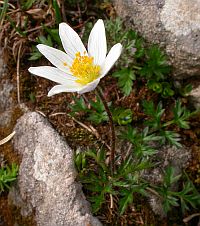 Anemone pavoniana
© Teresa Farino
Anemone pavoniana
© Teresa Farino
After a chilly night, there were few moths in the trap, the most spectacular being a Fox Moth. However,
the weather soon brightened and we had fine views of the peaks and the Isard (Pyrenean Chamois) as we emerged from
the upper cable car station above Fuente Dé. The ground was littered with Ranunculus amplexicaule (Amplexicaule
Buttercup), the local endemic Anemone pavoniana, drifts of tiny daffodils Narcissus asturiensis and blue
splashes of Gentiana verna (Spring gentian) and G. angustifolia (Pyrenean Trumpet Gentian). Alpine choughs
wheeled overhead and we had good views of Alpine Accentor and Snow Finch. On our way across to a clear alpine pool, home to
Alpine Newts and Midwife Toads, we saw the beautiful lemon-yellow of Saxifraga felineri, the generic name referring not
only to the plant breaking stone but also medicinally having been used for the dissolving of 'stones.'
Mary Clare Sheahan described the enormous, mating Common Toads in the second pool as "turning out spawn like ticker-tape"!
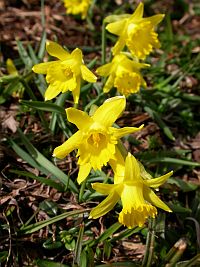 Narcissus asturiensis
© Teresa Farino
Narcissus asturiensis
© Teresa Farino
As the season was late, there were not sheets of flowers but the occasional, colourful splash of Gagea lutea
(Yellow Star of Bethlehem), Pulsatilla vernalis (Spring Pasque Flower), and Saxifraga oppositifolia (Purple
Saxifrage). After lunch at the foot of the cable-car, we explored the scree-fans in the adjacent pasture, which turned up
Aquilegia vulgaris (Columbine), Linaria alpina ssp. filicaulis (a Picos endemic subspecies of Alpine
Toadflax), Reseda glauca (Pyrenean Mignonette), Vicia pyrenaica (Pyrenean Vetch) and Botrychium lunaria
(Moonwort), and all topped off with a wonderful blue haze of Echium vulgare. Back at the hotel we celebrated
with a birthday cake for Mark Howarth.
4 June - Frama & Piedrasluengas
Our first stop was a roadside meadow near Frama, where west-facing shaly cliffs revealed Dorycnium pentaphyllum,
Thymus mastichina, and Cistus salviifolius, Unfortunately the meadow itself it had just been cut,
so that a litter of tall Himantoglossum hircinum (Lizard Orchids) was strewn across the ground. An unusual,
bright scarlet fungus - Clathrus archeri - was also a victim. Arthur Copping had meanwhile been combing the
verge for grasses and found a new species for the Picos: Poa angustifolia (Narrow-leaved Meadow-grass).
Further on we were shown the local endemic Echium cantabricum, which is restricted to the area around the
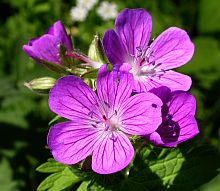 Wood Crane's-bill
Wood Crane's-bill
Geranium sylvaticum
© Teresa Farino
Piedrasluengas pass - our main destination for the day - where we explored a Carboniferous limestone gorge,
extensive wet meadows by the river, isolated rock outcrops, sloping, sub-alpine grasslands and beechwood hangers.
Ranunculus aconitifolius (Aconite-leaved Buttercup), Narcissus pseudonarcissus ssp. nobilis
(Wild Daffodil), Geum rivale (Water Avens) and Geranium sylvaticum (Wood Crane's-bill) were scattered in
the wetter places, while Ranunculus gouanii (Gouan's Buttercup), Meum athamanticum (Spignel),
Potentilla montana and the Iberian endemic Viola bubanii (Violet Mountain Pansy) were in flower
on the upper, drier grasslands. In the woodland, Polygonatum verticillatum (Whorled Solomon's Seal),
Lilium martagon and Actaea spicata (Baneberry) were located after a search. On the sun- baked rocks
Thlaspi perfoliatum (Perfoliate Penny-cress), Arabis scabra (Bristol Rock-cress),
Trinia glauca (Honewort) and Allium sphaerocephalon (Round-headed Leek) made us feel that
we might be in the Avon Gorge!
5 June - transfer to Valdeón via San Glorio
We transferred from Espinama to Posada de Valdeón further west via a circuitous, but scenically and botanically
interesting route, travelling up the Valle de Cereceda where we saw a tall 'heath' composed of Halimium lasianthum
ssp. alyssoides, Pterospartum tridentatum and Erica australis (Spanish Heath),
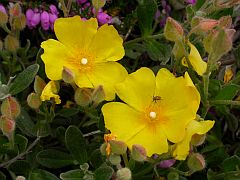 Halimium lasianthum ssp. alyssoides
© Teresa Farino
before visiting the splendid wet meadows near San Glorio, which hosted Nigritella gabasiana,
Viola cornuta (Horned Pansy), and Pedicularis mixta. The surrounding scrub was composed
primarily of Genista obtusiramea, while sunny banks turned up Phalacrocarpum oppositifolium,
both Iberian endemics.
Halimium lasianthum ssp. alyssoides
© Teresa Farino
before visiting the splendid wet meadows near San Glorio, which hosted Nigritella gabasiana,
Viola cornuta (Horned Pansy), and Pedicularis mixta. The surrounding scrub was composed
primarily of Genista obtusiramea, while sunny banks turned up Phalacrocarpum oppositifolium,
both Iberian endemics.
Lunch was at the water-meadows of the Arroyo de Mostajal, where Tozzia alpina (Tozzia) and Tulipa sylvestris ssp. australis (Wild Tulip) were highlights. The large tussocks of Festuca paniculata ssp. spadicea impressed Arthur, while a dry knoll had Arnoseris minima (Lamb's Succory), which most of us failed to recognise as it is now extinct in Britain! Here too were Ranunculus nigrescens, Linaria elegans and the seed capsules of Narcissus triandrus, also new species for the trip.
The drivers dropped off their passengers at the charming, traditional hill village of Santa Marina de Valdeón for a short walk down to our second hotel in Posada de Valdeón, between the floriferous banks of the single-track winding road. The banks had Campanula rapunculus (Rampion Bellflower), Linum narbonense (Beautiful Flax), Herniaria hirsuta (Hairy Rupturewort), and several Orobanche spp. (Broomrapes). Luckily, the drivers just missed the after-work rush up the single-lane road through the valley in the opposite direction!
6 June - Arroyo de Cable
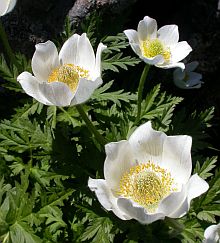 Pulsatilla alpina ssp. cantabrica
© Teresa Farino
Pulsatilla alpina ssp. cantabrica
© Teresa Farino
We explored the Arroyo de Cable valley, south west of Posada, on the northern slopes of the Cordillera Cantábrica, cadging a lift in a 4WD-taxi on the way up. The valley extended from beech forest up to idyllic, summer-grazed pastures, surrounded by a backdrop of impressive crags with lingering snow patches. The underlying geology is Devonian shales mixed with conglomerates and is acid, hosting Pulsatilla alpina ssp. cantabrica and Orchis pallens, (Pale-flowered Orchid) in the drier meadows, Veratrum album (White False Helleborine) and Swertia perennis (Marsh Felwort) in the wet flushes, and Cryptogramma crispa (Parsley Fern) and Saxifraga spathularis (St Patrick's Cabbage) on the rocks.
As we climbed further up through a blue haze of Scilla verna (Spring Squill), dry heath replaced the grassland and we found Luzula nutans, Erica arborea (Tree Heath), Rosa pendulina (Alpine Rose), Geranium cinereum ssp. subargenteum (Ashy Crane's-bill), Pinguicula grandiflora (Large-flowered Butterwort) and Homogyne alpina (Alpine Colt's-foot), plus the endemic, white-flowered crucifer Teesdaliopsis conferta on patch of loose shale.
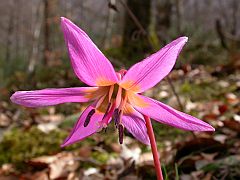 Dog's-tooth-violet
Dog's-tooth-violet
Erythronium dens-canis
© Teresa Farino
At the head of the valley at 1600m was a basin mire with Sphagnum species and clear pools. Nearby were Fritillaria pyrenaica (Pyrenean Snakeshead), Narcissus bulbocodium (Hoop-petticoat Daffodil) and Erythronium dens-canis (Dog's-tooth-violet), which were much -worshipped by the keen photographers. There were, for us British botanists, some unusual combinations of plants: Calluna vulgaris (Heather), growing with Helleborus viridis (Green Hellebore) and Daphne laureola (Spurge Laurel). A memorable sight of about 40 Isard, conspicuous on the snowy crags, caught our attention on our way back down to a late lunch under the shade of a large Sorbus aria (Common Whitebeam).
The lower, stony slopes were completely lit up with the warm yellow of the sweet-scented, blossoming Genista hispanica ssp. occidentalis. Just before boarding the buses, we located a new colony of the scarce Chequered Skipper butterfly, a fresh specimen of the Tao Emperor moth, and a spectacular, pale-yellow-flowered spike of Pedicularis foliosa (Leafy Lousewort).
7 June - Posada to Cordiñanes
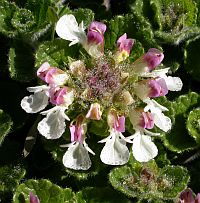 Pyrenean Germander
Pyrenean Germander
Teucrium pyrenaicum
© Teresa Farino
After finding a magnificent female Emperor Moth on the bulb of the moth trap, we strolled along the local pathways from our hotel up to the wonderful meadows en route to the next village of Cordiñanes. A Red-backed Shrike and a Camberwell Beauty were spotted, while Bonelli's Warbler and Iberian Chiffchaff heard singing. Butterflies abounded in the meadows with yet another Chequered Skipper, Black-veined White, Mazarine, Turquoise and Short-tailed Blues and Spanish Swallowtail among the most notable. Various Serapias spp. were admired, including S. vomeracea, located by Phyl Abbot, while Coeloglossum viride (Frog Orchid) was found in scattered patches, plus Phyteuma orbiculare (Round-headed Rampion) and the leaves of Iris latifolia (English Iris).
After lunch outside the local pub, where we kept retreating into the limited area of shade because of the rising
temperatures, we crossed over the River Cares to the Mirador, where we saw the start of the gorge in the distance.
Centaurea calcitrapa (Red Star-thistle) was seen on the bare areas, and Teucrium pyrenaicum (Pyrenean
Germander) was seen in flower for the first time. The startling, large whitish-pink flowers of Linum
suffruticosum ssp. salsoloides (Pyrenean Flax) caught everyone's eye, along with Polygonatum
odoratum (Angular Solomon's Seal) . Rock outcrops were festooned with stonecrops including Sedum brevifolium
(Short-leaved Stonecrop) and the Iberian endemic S. arenarium, also hosting Hypericum linariifolium
(Toadflax-leaved St John's-wort). We just had time to see Crepis albida ssp. asturica (Pyrenean Hawk's-beard)
before the looming dark clouds brought us the first rain of the trip, as we hurried the last few metres back to the hotel.
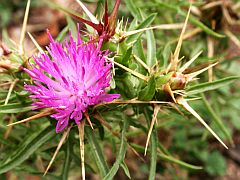 Red Star-thistle
Red Star-thistle
Centaurea calcitrapa
© Teresa Farino
8 June - Castilian Plains: Cistierna
The sun rose and touched the crags surrounding the valley on our last full day in the Picos, but it was the Transit of Venus which really caught our imagination. We set up the telescope in the hotel car park and were delighted as we saw the image projected onto a sheet of white paper. Mark Howarth was the principal astronomer, ably assisted by Jean Kendrew explaining the physics. We photographed the event and the image first at 0915 and then several more times along our journey until the last view was obtained at 1315. The Guardian reported that in 1882 Robert Ball wrote " The next time will see it (the transit) is when the flowers are in bloom in June 2004". This was certainly true for us as a group: the flowers were also superb.
En route southwards to 'The Plains of Castile', we stopped briefly in the beech cloud-forest, where lichens 'dripped' off the moisture-laden trees. Here grew Scilla lilio-hyacinthus (Pyrenean Squill) with Euphorbia hyberna ssp. hyberna (Irish Spurge), Cardamine raphanifolia, Polygonatum verticillatum, Paris quadrifolia, and Pyrola minor (Common Wintergreen). Further on, into the flat lands, we saw storks nesting on the bell towers of nearly every village church.
 Pyrenean Squill
Pyrenean Squill
Scilla lilio-hyacinthus
© Teresa Farino
We reached the open limestone areas near Cistierna where there were many pretties, including Aphyllanthes monspeliensis (Blue Aphyllanthes), Bellardia trixago (Bellardia), Catananche caerulea (Blue Cupidone), Anagallis monelli (Shrubby Pimpernel), the pale-pink Convolvulus cantabrica, three species of flax - the blue Linum narbonense, the pinkish-white L. suffruticosum ssp. apressum (White Flax), and the yellow L. strictum (Upright Flax) - and masses of Himantoglossum hircinum at last. Nightingales and Melodious Warblers serenaded us and Purple-shot Coppers and Swallowtails floated by. In an arable area across the road we found more British rarities in one field than most people had seen in Britain as a whole, with colour provided by Vicia pannonica (Hungarian Vetch), Althaea hirsuta (Rough Marsh-mallow) and Anchusa azurea (Large Blue Alkanet).
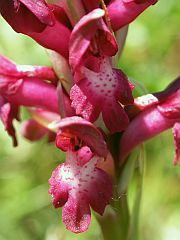 Bug Orchid
Bug Orchid
Orchis coriophora
© Teresa Farino
Another roadside stop near Mondreganes yielded a cereal field teeming with Papaver rhoeas (Common Poppy), Centaurea cyanus (Cornflower), Agrostemma githago (Corncockle) and Matricaria recutita (Scented Mayweed). Lunch by the river gave us chance to observe the Beautiful Demoiselle damselfly, Iberian Water Frog, Viperine Snake, Marbled Newt, a red-and-black striped oil beetle (Berberomeloe majalis) and a praying mantis (Empusa pennata) nymph. Nearby we found Orchis coriophora (Bug Orchid) and Dactylorhiza elata (Robust Marsh Orchid), in the verges of cereal fields where a Montagu's Harrier quartered the ground. A plant new to Teresa, Myosurus minimus (Mousetail), although rather dried-up, was found by Mark Kitchen in a ditch here.
On the return route we explored an area of gravel workings which now had many small ponds providing homes for frogs, toads and dragonflies, as well as suitable habitats for many butterflies and moths. The final stop of the day was at the viewpoint, or Mirador de Valdeón, to admire the 'puce-coloured' flowers of the Iberian endemic toadflax Linaria triornithophora and, of course, the view down to the distant village that had been our welcome home for the last five days.
June 9 - return to Bilbao
An early start, a drive through the spectacular Desfiladero de los Beyos, and breakfast at the 'Blue cafe' on our way back to Bilbao airport,
signified the end of a very pleasant and rewarding BSBI field meeting in the Picos de Europa.
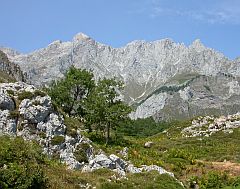 Ándara
© Teresa Farino
We recorded almost 800 species of plant and added several new ones to Teresa's list: for example, the small, yellow-flowered member of the Scrophulaceae which puzzled everyone in the meadow at Fuente Dé. It was collected by Graeme Kay and sent off to Eric Clement, who pronounced it to be Triphysaria pusilla (Orthocarpos pusillus): a western North American species. It is apparently the first record of this plant being established in the wild in Europe.
Ándara
© Teresa Farino
We recorded almost 800 species of plant and added several new ones to Teresa's list: for example, the small, yellow-flowered member of the Scrophulaceae which puzzled everyone in the meadow at Fuente Dé. It was collected by Graeme Kay and sent off to Eric Clement, who pronounced it to be Triphysaria pusilla (Orthocarpos pusillus): a western North American species. It is apparently the first record of this plant being established in the wild in Europe.
This report was written by the members of the party - Phyl Abbott, Arthur Copping, Karl Crowther, Lynne Farrell,
Jane Greatorex, Mark Howarth, Graeme Kay, Jean Kendrew, Mark and Clare Kitchen, Louise Redgrave, Ann Sankey, Mary Clare
Sheahan, Jill Sutcliffe and John Swindells - and was edited by Teresa Farino. It was previously published in
BSBI News 97; 66-69 (September 2004).
Natural history tours in the Picos de Europa:
A Feast of Flowers - botanical trips to the Picos de Europa
A Family Wildlife Holiday in the Picos de Europa
Butterflies and Moths of the Southern Valleys of the Picos de Europa
Natural History of the Picos de Europa and Páramos of Northern Castile
Daily wildlife excursions in the Picos de Europa
Reports of other botanical trips in Spain and Portugal:
IWT Feast of Flowers in the Picos de Europa - Trip report 2009
BSBI Botanical Tour in the Castilian Páramos - Trip Report 2009
BSBI Botanical Tour in the Valle de Benasque - Trip Report 2008
BSBI Botanical Tour in the Sierra de Grazalema - Trip Report 2007
BSBI Botanical Tour in Western Portugal - Trip Report 2006
BSBI Botanical Tour to the Catalan Pyrenees - Trip Report 2005
Related information:
Picos de Europa - a naturalist's paradise
Complete list of orchids for the Picos de Europa
Read about Teresa Farino
Botanical holidays in Spain & Portugal
|